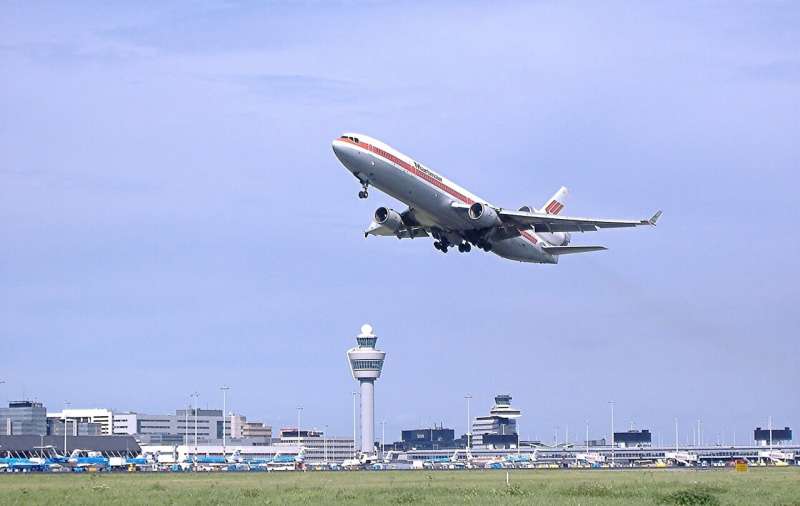June 5, 2023 report
This article has been reviewed according to Science X's editorial process and policies. Editors have highlighted the following attributes while ensuring the content's credibility:
fact-checked
trusted source
proofread
Engine treatment can slash jet noise

There's a song anyone who lives near an airport or directly under the flight path of incoming and departing jets daily wishes they could play: Simon and Garfunkel's "The Sound of Silence."
How bad is airplane noise? In a 2022 report, scientists in New Jersey—which, as the most congested state in America, knows a thing or two about noise—said that residents living in noise-polluted areas such as airports suffer heart attack rates 72% higher than those in quieter regions. Rutgers Robert Wood Johnson Medical School Professor Abel Moreyra said noise pollution must be considered a contributor to heart disease.
In London, the Aviation Environmental Federation recently declared, "Aircraft noise can impact memory and learning in children, disturb sleep, and cause serious long-term health problems."
A Belgian environmental group estimated the health costs for residents suffering under the clamor of airports total more than 1 billion euros (1.07 billion in U.S. dollars). They calculated that 51,000 people have a heightened risk of developing high blood pressure and 2,000 people face a greater risk of heart disease due to disrupted sleep and constant daytime noise from airports.
The European Union has issued a directive barring excessively loud airlines from flying in European airspace.
Belgium began taking action to curb jet noise in April as it imposed taxes on short-haul flights and private jets.
And BWI Airport in Baltimore has begun a $35 million multiyear project to install soundproofing for more than 400 homes surrounding the busy—and quite noisy—terminal.
Amid rising concerns about the harmful effects of noise, there is now welcome news from Shanghai University. A team of researchers has developed a model that Interesting Engineering called "a groundbreaking" advance that will sharply curb the ear-splitting noise of jet engines.
In their paper, "Noise control for high subsonic jet flows by inner wall treatment," published in May in Advances in Aerodynamics, researchers detailed numerous simulations they conducted in air turbulence, aeroacoustics and hydrodynamics.
They relied on classic works such as the Ffowcs Williams–Hawkings equation, widely used to assess sounds generated by aircraft propellers, helicopter rotors and turbo machinery. John Ffowcs Williams was best known for his contributions to the design of the supersonic Concorde jet.
The Shanghai team investigated issues such as shear layer instability, flow field and far field noise.
What they came up with is a jet engine treatment called wavy inner wall (WIW) in which they replaced the smooth inner wall found by the exit of the nozzle with walls containing wavy patterns. A nozzle is a specially shaped tube carrying hot gases that produce thrust.
The concept, first proposed by MIT researchers in 2019, "enables control of fine scale turbulence" according to Huyue Mao, one of the Shanghai researchers.
The result is "reduction of mid- to high-frequency noise," Mao said.
The Shanghai WIW solution improves upon earlier efforts by others that hindered engine thrust or required additional devices to meet noise and thrust objectives.
The Shanghai remedy offers low thrust loss and does not depend on other structures to achieve significant noise reduction.
"The wavy wall control method induces very small geometrical modifications, which introduces a trivial sacrifice in thrust while enhancing shear layer mixing," Mao said. "As a result, the wavy wall is a promising method for flow and noise control for subsonic jets."
Pretty soon, as the concept is further refined and eventually brought into production, we may be able to join Simon and Garfunkel, the pop duo who grew up minutes from one of the world's busiest airports (JFK in Queens, New York), in a refreshingly peaceful recital of "The Sound of Silence."
More information: Huyue Mao et al, Noise control for high subsonic jet flows by inner wall treatment, Advances in Aerodynamics (2023). DOI: 10.1186/s42774-023-00149-x
© 2023 Science X Network



















